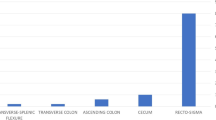Abstract
Background
Although the incidence of perforation after endoscopic procedures of the colon is low, the rising number of diagnostic colonoscopies could pose relevant health problems. Optimizing treatment may reduce the probability of severe complications. This study aimed to determine perforation frequency and the management of perforations that occurred during diagnostic colonoscopy.
Methods
A retrospective review of patient records was performed for all patients with iatrogenic colonic perforations after sigmoidoscopy/colonoscopy from 2000 to 2011 in three institutions of The Catholic University of Korea. The patients’ demographic data, endoscopic procedure information, perforation location, therapy, and outcomes along with different therapeutic strategies were recorded.
Results
In the 12-year period, a total of 115,285 diagnostic sigmoidoscopic/colonoscopic procedures were performed. A total of 27 perforations occurred. Sixteen patients underwent endoscopic clipping, of which three patients failed and were referred for surgery. Fourteen patients in total underwent surgery for perforation. Endoscopic clip closure was successful in 81 % of the patients. No perforation-related major morbidity or mortality occurred.
Conclusion
Endoscopic repair using clips can be effective for the treatment of colon perforations that occur during diagnostic colonoscopy.

Similar content being viewed by others
References
Wullstein C, Koppen M, Gross E (1999) Laparoscopic treatment of colonic perforations related to colonoscopy. Surg Endosc 13:484–487
Cho SB, Lee WS, Joo YE, Kim HR, Park SW, Park CH, Kim HS, Choi SK, Rew JS (2012) Therapeutic options for iatrogenic colon perforation: feasibility of endoscopic clip closure and predictors of the need for early surgery. Surg Endosc 26:473–479
Jovanovic I, Zimmermann L, Fry LC, Monkemuller K (2011) Feasibility of endoscopic closure of an iatrogenic colon perforation occurring during colonoscopy. Gastrointest Endosc 73:550–555
Katsinelos P, Kountouras J, Chatzimavroudis G, Zavos C, Pilpilidis I, Tzilves D, Paroutoglou G (2009) Endoscopic closure of a large iatrogenic rectal perforation using endoloop/clips technique. Acta Gastroenterol Belg 72:357–359
Magdeburg R, Collet P, Post S, Kaehler G (2008) Endoclipping of iatrogenic colonic perforation to avoid surgery. Surg Endosc 22:1500–1504
Yang DH, Byeon JS, Lee KH, Yoon SM, Kim KJ, Ye BD, Myung SJ, Yang SK, Kim JH (2010) Is endoscopic closure with clips effective for both diagnostic and therapeutic colonoscopy-associated bowel perforation? Surg Endosc 24:1177–1185
Luning TH, Keemers-Gels ME, Barendregt WB, Tan AC, Rosman C (2007) Colonoscopic perforations: a review of 30,366 patients. Surg Endosc 21:994–997
Damore LJ 2nd, Rantis PC, Vernava AM III, Longo WE (1996) Colonoscopic perforations. Etiology, diagnosis, and management. Dis Colon Rectum 39:1308–1314
Cobb WS, Heniford BT, Sigmon LB, Hasan R, Simms C, Kercher KW, Matthews BD (2004) Colonoscopic perforations: incidence, management, and outcomes. Am Surg 70:750–757
Lo AY, Beaton HL (1994) Selective management of colonoscopic perforations. J Am Coll Surg 179:333–337
Avgerinos DV, Llaguna OH, Lo AY, Leitman IM (2008) Evolving management of colonoscopic perforations. J Gastrointest Surg 12:1783–1789
Hanson JM, Atkin WS, Cunliffe WJ, Browell DA, Griffith CD, Varma JS, Plusa SM (2001) Rectal retroflexion: an essential part of lower gastrointestinal endoscopic examination. Dis Colon Rectum 44:1706–1708
Varadarajulu S, Ramsey WH (2001) Utility of retroflexion in lower gastrointestinal endoscopy. J Clin Gastroenterol 32:235–237
Mattar WE, Kumar AS, Olden KW (2011) Perspective on routine rectal retroflexion during screening colonoscopy: a survey of American gastroenterologists. J Gastrointest Liver Dis 20:102–103
Iqbal CW, Cullinane DC, Schiller HJ, Sawyer MD, Zietlow SP, Farley DR (2008) Surgical management and outcomes of 165 colonoscopic perforations from a single institution. Arch Surg 143:701–706
Anderson ML, Pasha TM, Leighton JA (2000) Endoscopic perforation of the colon: lessons from a 10-year study. Am J Gastroenterol 95:3418–3422
Disclosures
Drs. Joon Sung Kim, Byung-Wook Kim, Jin Il Kim, Jeong Ho Kim, Sang Woo Kim, Jeong-Seon Ji, Bo-In Lee, and Hwang Choi have no conflicts of interest or financial ties to disclose.
Author information
Authors and Affiliations
Corresponding author
Rights and permissions
About this article
Cite this article
Kim, J.S., Kim, BW., Kim, J.I. et al. Endoscopic clip closure versus surgery for the treatment of iatrogenic colon perforations developed during diagnostic colonoscopy: a review of 115,285 patients. Surg Endosc 27, 501–504 (2013). https://doi.org/10.1007/s00464-012-2465-3
Received:
Accepted:
Published:
Issue Date:
DOI: https://doi.org/10.1007/s00464-012-2465-3




